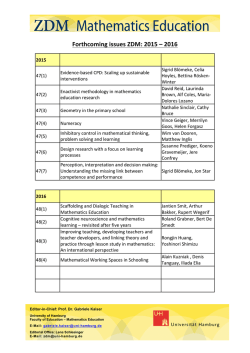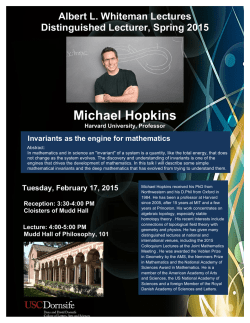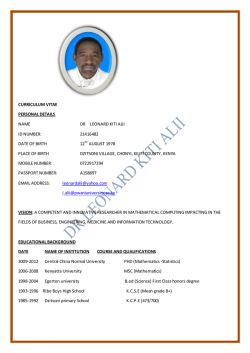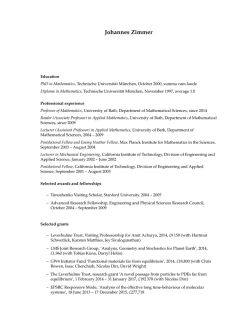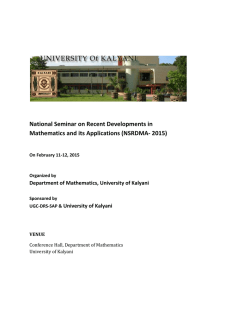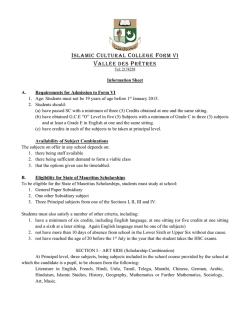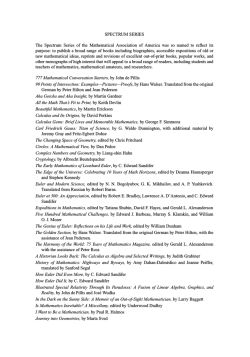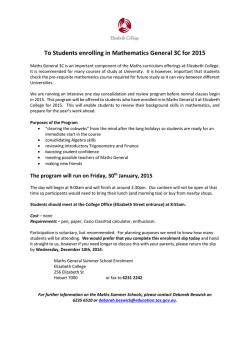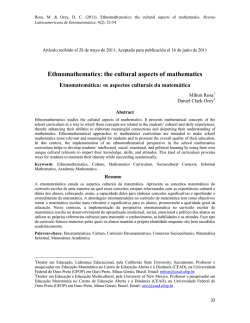
Researching today will help safeguard tomorrow CONTENTS
Quarterly newsletter Third quarter 2015 CSIC - UAM - UC3M - UCM EDITORIAL Researching today will help safeguard tomorrow AXA Jean-Paul Rignault, CEO of AXA Spain and President of the AXA Foundation According to the estimates we have made at AXA, life expectancy at birth in Spain is rising at a rate of 4.8 hours per day. This is undoubtedly one of the indicators most revealing of our society’s level of development. This is not by chance, as life expectancy at birth is precisely one of the factors comprising the UNDP (United Nations Development Program) Human Development Index (HDI). Longevity is increasing – at least in Spain – at an unprecedented rate, the result of the heightened well-being we have been experiencing over recent decades. And ultimately responsible for this improvement in living conditions which is making us live longer is none other than Science, in all its disciplines. Even if one wanted to, no society can live turning its back on Science, because – in my opinion, at least – the interest in understanding and figuring out the world around us is inherent to the human condition. Besides, the States and their governments have, as guarantors of the welfare of the citizens they serve, the responsibility of promoting, training and applying scientific knowledge for the benefit of all concerned. They are the main driving force, but not the only one. Companies, as the social agents which they are, also have the responsibility, regardless of the business activities in which they are involved, of contributing toward improving human life by way of supporting Science. In fact, many of them do so out of sheer need. In many cases, what sets apart the good or service they market from that of their competitors (what gives them the competitive edge) is the result of scientific research. Hence, in the developed countries, the companies and the scientific community are two agents condemned to see eye to eye with one another. For example, the increased life expectancy involved in the scientific advancements is linked to the aging of the population, which is the main challenge, according to the EU, that we are going to have to face in the future. In this regard, the insurance sector in general and AXA in particular can contribute their experience to the socio-demographic implications which such a major challenge as this is going to entail. As an insurance company, we believe it to be part of our corporate responsibility to contribute to the research on the risks which the societies are going to be facing for the purpose of improving their prevention and, if they occur, of protecting people as best possible against their consequences. Although the knowledge may be based, at the start, on the analysis of the field data, in a progressively more changing world, our societies cannot concentrate solely on the past to explain the future, nor can we simply adapt the currently-existing models to what is yet to come. This was the reason why, some years ago, the AXA Group 1 Jean-Paul Rignault, CEO of AXA Spain and President of the AXA Foundation. CONTENTS Editorial: “Researching today will help safeguard tomorrow”..............................................................1 Interview: Jim Simons............................................2 Report: “Laying siege to uncertainty”....................4 Interview: Eva Chen...............................................7 Self-portrait: Sergei Kuksin...................................8 Scientific review: Yang-Mills Theory and Jumping Curves....................................................................9 Profile: Roger Casals............................................10 News ICMAT..........................................................11 Agenda.................................................................13 created AXA Research Fund, an academically independent entity supporting the scientific research of the risks in three main areas: the environment (from climate change to volcanic risks, including biodiversity), life (longevity, diseases, health policies, etc.) and society (from finances to sociopolitical risks). Since its creation in 2007, this philanthropic initiative has allocated a total of 131 million euros, with which it has financed 449 projects throughout the world. Additionally, we have our own individual way of viewing scientific patronage. Besides supporting academic research worldwide by encouraging exploring new pathways to knowledge, we believe it of crucial importance to contribute to the dissemination of the scientific discoveries by stirring debate beyond the bounds of the scientific community proper. So that we will help toward bringing the scientific world and the rest of the citizenry closer together, they shall not think of science as something totally unrelated to their own lives. AXA uses its corporate networks and communications resources throughout the world to aid scientists, whom it helps share their knowledge with the wider-ranging public, thus aiding toward actively nourishing public debate concerning the risks threatening our societies. Mention may also be made of the importance which public/private collaboration has for the development of Science in a country. One of the main obstacles which basic research is facing here in Spain is funding. Most of the projects cannot be approached on a short or medium-term time horizon, which is what public funds usually guarantee. Because many of them require several years to start bearing their first fruits. Being left hanging in the balance not knowing whether they will avail of funding the following year in order to continue researching does nothing but distract scientists from what is really important. That is why the AXA Research Fund’s main funding concept is endowment or perpetual funds. Endowment (capitalization fund) is an amount which is invested in financial products or funds such that the interest generated by these amounts paid in are the capital which is allocated in the end to the ongoing support of research. This is a widely-used approach in the English-speaking world, albeit not very well known in Spain. The promotion and appropriate tax treatment on the part of the public institutions would be a determining factor for science in Spain On the other hand, AXA has also bolstered its scientific patronage endeavor in Spain at the hand of the Atresmedia communications group with the creation of “Constantes y Vitales”, a platform with the objective of supporting and boosting quality medical research and health prevention by means of starting up awareness-heightening initiatives which will contribute toward matters including highlighting the importance of researchers, curtailing the talent drain and disseminating advice serving as effective health prevention tools for the citizenry. And now barely a few months old, we can say that we have already achieved the first major objective: the creation of the State Research Agency. After nearly 72,000 people had joined in to support the AXA and Sexta petition, the Minister of Economy and Competitiveness, Luis de Guindos, announced this autonomous body being gotten under way for the management and development of Spain’s scientific research. Science is not currently experiencing the best of times in Spain. Like so many other sectors, it has been severely affected by the economic crisis. Therefore, now more than ever, we must safeguard it. It cannot be allowed to wither and fade. Because if Science fades away, we too shall be fading away. ICMAT INTERVIEW: Jim Simons, “Mathematics has earned me a lot of money” “I left research because I wanted to do something different” Q: What does mathematics mean for you? Ágata Timón. James Harris Simons (1938, USA) was without doubt one of the most popular figures at the International Congress of Mathematicians held in Seoul (South Korea) in 2014. His talent for converting mathematical knowledge into one of the biggest fortunes in the world (he is number 96 on the list of the richest people in the world according to Forbes Magazine) caught the attention of the South Korean public and the media. Even more than that, his contributions to mathematics (especially the famous Chern-Simons theory) and his ability to surpass and reinvent himself make him something akin to a movie star. We talked to him about the different stages in his career (as a researcher, then as an investor and now as a philanthropist), the patronage of science and his life in mathematics in general, which was the title of the public talk he gave at the congress. A: On the one hand, I enjoyed doing research in pure mathematics. I love it, and I think mathematics is beautiful. On the other, its applications, particularly in the financial market, which has earned me a lot of money, and I also enjoyed constructing the models we worked with. Q: You’ve said that mathematics saved you after the death of your son. How did it help you? A: The death of my second son was totally devastating, and mathematics provided a relief for me. It gave me the chance to escape from myself, inside my own head, without dwelling on all the bad things that had happened. When you’re doing mathematics you think very deeply and you get away from reality. This situation brought me back to the field of research. 2 Quarterly Newsletter Third quarter 2015 ICMAT Q: Years before that you were awarded the Oswald Veblen Prize, the highest honor in the field of geometry, for your ChernSimons theory. Could you tell us something about that theory? A: It’s rather difficult to explain; it belongs to the field of differential geometry. Although it was a theoretical result, the geometrical configuration in which the invariants we were studying appear, also turned out to be the geometrical configuration that enables certain physical phenomena to be explained. Q: Why did you decide to move from mathematical research to fund management? A: The first time I changed jobs was because I wanted to do something different. In the last two years I’ve been a philanthropist. I made this second change because I was getting too old to manage an investment fund, and it was time to make way for younger people. “The two things I’m most proud of are the Chern-Simons theory and having built up my company” Q: What do you regard as the greatest success in your life? A: I think the two things I’m most proud about are the Chern-Simons theory and building up the company Renaissance Technologies. Q: What’s the key factor in the success of the company? A: We’ve been working in this field for more than 30 years. We’ve learned a lot about prediction and modeling, but I can’t share that technical knowledge. When the company ceases to exist we’ll be able to reveal all our secrets. Q: In general terms, could you tell us how you apply mathematics to the financial sector? A: We make models in order to understand the evolution of the market. We study past events and observe a large variety of factors that determine developments in the market. We study these situations, gather the data and look for things that are not random and which are repeated. The secret is to have a lot of models at the same time. You’re not going to get it right every time; in fact you’re not going to get it right much more than 50% of the time, but if you have enough investments you’ll get a return. “We make models in order to understand the evolution of the market” Q: What kind of work do mathematicians do in the financial market? A: A lot of work requires knowledge of statistics as well as mathematics, especially in the area of risk control, in order to measure the risk associated with the purchase and sale of financial products. On the stock market… people with mathematical training have excellent jobs in many fields of finance. Q: What role have mathematicians played in the financial crisis? A: The cause of the crisis was that people were buying products that were not good. In my company we didn’t design financial products. That’s what the banks were doing, but the data they were working with weren’t all correct, so there were mismatches in their estimations. And the credit rating agencies, which are supposed to approve these products, either didn’t have very good analysts or were too concerned with collecting their fees, and gave them the seal of approval. “The cause of the crisis was that people were buying products that were not good” 3 After stepping down as director of the Renaissance Technologies Corporation, Simons now devotes his time to philanthropy. Q: Why did their estimates fail? A:The models were valid, but in order for them to function they needed the right historical data. Certain assumptions were made that were not correct. One of them, for example, was that house prices were never going to fall. If you think about it a little it’s quite a stupid prediction, although in recent history it seemed to be true: house prices never went down. However, if they had seen that indeed there were times when house prices fell then they would have realized that the presumption was risky. “People with mathematical training have excellent jobs in many fields of finance” Q: In what other industries besides the financial markets do you think mathematics will be useful? A: In practically all of them; Google and in general all search engines are based on mathematics. Medical imaging is based on mathematics, and telecommunications is as well. I think you can find mathematics everywhere. Q: What beneficial projects by the Simons Foundation would you care to mention? A: Mainly our support for basic science; we’ve been backing research into the causes of autism for about ten years. We’ve also got projects in physics, in neuroscience… on the origins of life. How did life begin? How did RNA and DNA develop from primitive conditions? These are very complicated questions, but progress is being made. Q: Why do you think it is important to fund basic science? A: First of all, because it doesn’t receive the support it deserves. Federal funding for research in the USA is mainly devoted to applications. Applications are important, but at bottom there is this basic understanding of the world we live in. This fundamental understanding isn’t necessarily applicable to anything immediately, only for comprehending how things work, but surprisingly it often ends up by producing applications. The person who discovered that genetic material was made up of DNA wasn’t thinking about the human genome project at the time, or about all the medical applications that are currently being developed in genetics as a result of that discovery. He was probably only interested in finding out what genetic material was and what it was made of. “Basic science doesn’t receive the support it deserves” A: Yes, we have an educational program on mathematics and sciences at New York schools that is enjoying a great deal of success. mathematics have many career opportunities they didn’t have before. Meanwhile, schools don’t sufficiently reward people who are versed mathematics. What we’ve done is create a group of mathematics and science teachers who receive an extra payment through the “Math for America” program. At the moment there are 800 teachers and next year there’ll be 1,000, which is 10% of all the teachers in the city of New York. So they feel rewarded and respected and pursue their careers in teaching. I think this is what’s required. “One of the main problems is that teachers in colleges and institutes don’t have enough mathematics” “Schools don’t sufficiently reward people who are versed in mathematics” Q: You also carry out educational schemes through the Foundation, don’t you? Q: How does that work? A: One of the main problems is that teachers at colleges and institutes don’t have enough mathematics, and they’re not prepared for teaching students. Years ago, one of the few decent jobs a person with a degree in mathematics could do was teach at an institute. At that time there were no computers or exciting jobs that drew people with mathematical knowledge away from education. But today there are many industries based on mathematics and other sciences, so there are a lot of jobs that require mathematical knowledge and people with degrees in Q: You fund part of the prizes awarded at the ICM. What do you think of the latest prize-winners? A: They’re all impressive. I wish I had a medal! I have to say that it was great to see a woman win a Fields Medal. Women have gradually been entering into life sciences, biology, chemistry… There are great scientists in these fields, but mathematics and physics are still lagging behind. Fortunately, more and more women are devoting themselves to these areas, and Maryam Mirzakhani is an example of that. REPORT: An International Conference at the ICMAT brings together 50 Mathematicians, Experts in the Modeling of Decision-Making Depositphotos LAYING SIEGE TO UNCERTAINTY In most emergency situations it is vital to make quick decisions, which are inevitably biased by cultural contexts and personal opinions. In this scenario of paucity of information, mathematics may hold the key for reducing the margin of error. The use of probabilistic models enables subjective bias to be avoided as well as reducing uncertainty when making decisions. In April of this year, the ICMAT organized a series of talks by experts from all over the world who shared their experiences in this emerging field of research. Nuclear plant chimneys. 4 Quarterly Newsletter Third quarter 2015 By Mark Yokoyama Andrea Arnal. We live in an increasingly complex society where political and economic decisions have acquired a global dimension and frequently give rise to unexpected consequences. Humankind must face new challenges such as climate change or terrorism, which involve a large element of uncertainty. The case of terrorism is even more complex because it poses the presence of intelligent adversaries whose intentions it is necessary to attempt to foresee, and this requires the design of new tools and strategies to enable decisions to be modified according to the action adopted by our enemies. The decisions made in the first few hours of an emergency situation are crucial, but the information required to predict the outcome of one situation or another is normally not available, either for lack of data or lack of time. Given this uncertainty, and the need to make decisions quickly, politicians often rely on expert opinion to determine the best option open to them. However, specialists are prone to making recommendations that may be biased by their own beliefs, which in turn are determined by their own cultural and social contexts. This is where the mathematical modeling of expert judgement may be the key to mitigating biased opinions and striking a balance that makes it possible to arrive at a final decision in the most consistent and coherent manner. “Within a framework of uncertainty, it’s vital to model expert judgements mathematically in order to provide the right support for the process of decision-making in public policy” “Within a framework of uncertainty, it’s vital to model expert judgements mathematically in order to provide the right support for the process of decision-making in public policy,” says David Ríos, who occupies the AXA–ICMAT Chair in Adversarial Risk Analysis and is coorganizer of the “International Early Stage Researcher Training School on Applying Expert Judgement Methodologies to Real Problems” and the “Workshop on Expert Judgement for Geographical and Adversarial Problems”, which were held at the ICMAT from April 12th – 17th. The ICMAT welcomed some 50 international experts who came together to share the latest advances in this field, to help train new generations of mathematicians to tackle these new social challenges, and to show how, with the use of probabilistic models, mathematics can provide tools for decision-making in situations of uncertainty whether geographical or in the presence of adversaries. Responding with numbers The chief unknown quantity affecting these crisis situations may arise from two types of uncertainty: first of all, geographical, and secondly, the presence of intelligent adversaries. In the first case, it is essential to determine the spatial and temporal data connected with the event. For example, in crises caused by natural disasters and environmental accidents, such as oil spills, flooding, gas leaks or volcanic eruptions, then information about geodynamics, orography and meteorological conditions plays a vital role. In the second case of uncertainty, in which we are confronted by a protagonist with intelligence, it is important to determine the most likely decisions that may be made by such an adversary at any given moment. In this field, mathematics is closely linked with psychology, which enables patterns of behavior to be established in order to design mathematical models for decision-making. Furthermore, the modeling of opinion is combined with Game Theory. 5 Research in this field rose again after the 9/11 attack. This is a very recent field of research that gained momentum after the 9/11 attacks and which today has many applications in national security and defense systems, cyber-security, competitive marketing, markets and auctions. According to the latest results in the PandaLabs Report, compiled by Panda Security, the level of infection worldwide is currently estimated at 36.5%; that is, six points higher than for the same period in 2014. Understanding the adversary’s motivations One of the fields in which these mathematical developments are applied is cyber-security. It is becoming increasingly important to develop effective strategies to deal with the threats that constantly appear on the Internet. More than 225,000 cyber attacks across the globe are reported every day and this figure continues to rise. According to the latest results in the PandaLabs Report, compiled by Panda Security, the level of infections worldwide is currently estimated at 36.5%; that is, six points higher than for the same period in 2014. In Spain, it is estimated slightly above this average at 38.7% of all computers infected, although China heads the list and is followed by Turkey and Peru. States and institutions are not immune to this type of attack. The Spanish Centro Nacional de Inteligencia (CNI), whose task is to inform the Government on threats to national security, stability As pointed out by Einar Snekkenes, professor of Information Security at Gjovik University College (Norway), one of the speakers at the meeting in April, in order to respond effectively, “the key point is to focus on the interests and motivations of the adversary.” In addition to psychology, in Snekkenes’ opinion it is “very important” in this field to include disciplines such as economics, decision theory, computational sciences, and of course mathematics, in order to bring all this information together. As well as experts in cyber-security, the meeting was also attended by representatives from other fields, such as Alec Morton, an expert on the modeling of epidemics; Nicole Van Elst, whose research concerns the prediction of behavior; Stephanie Haywood, a specialist in the application of geographical uncertainty methods for the treatment of public health problems; Eva Chen, who coordinates a program based on the “wisdom of crowds” with the aim of forecasting global geopolitical changes, and Simon French, who collaborates with the UK Government on decision-making and risk analysis in real-world emergency situations. In the words of David Ríos: “We live in a risk society”, an interconnected global society in which risk continues to rise. It is for this reason that we call more and more on mathematical modeling as a tool that enables us to improve our response capability when faced with challenges posed in the 21st century. “During the first hours you don’t think, you act” Lucía Durbán Carmona. Professor Simon French (University of Warwick, UK) headed one of the most attractive sessions of the workshop on modeling expert judgement in which those attending the congress had the opportunity of exploring the information during a simulation of a nuclear accident. The session was held behind closed doors, but when it was over French summarized the chief conclusion for us, which has to do with the main challenge he has been working on in recent years: “The hardest and most difficult thing is making politicians understand that, even though everything is done properly, a certain degree of uncertainty remains. I mean, I know that it takes me 15 minutes to go from my house to work, but I also know that one day it could take 50.” “Money does not come into the decisionmaking process in the first few hours” French began his career as a “chalk and blackboard” researcher in statistical and probabilistic analysis, but after being invited to visit Chernobyl four years after the accident, his interests took a new turn and he is now one of the leading experts in decision-making in emergency situations; and not only in the nuclear sphere, because he was also involved in the “mad cow” crisis and other food and health related scares. Since then, his focus has become “highly multidisciplinary” and he is “half professor and half risk consultant”, and while from time to time he has worked with many major companies, his work consists in developing procedures and methods to help the UK and other European governments in the management of real emergencies involving the environment, public health, energy and the nuclear industry. “Poor responses to nuclear disasters such as Chernobyl and Fukushima are much, much less likely in Europe” In the wake of Chernobyl, all countries invested a great deal of money in risk analysis, and when the Fukushima disaster occurred in 2011 there were many models that proved useful, although others were not as effective as hoped because the two plants were very different, as were the causes of the accidents. Today, we can rest a little more assured; “poor responses to nuclear disasters such as Chernobyl and Fukushima are much, much less likely in Europe”. After a whole range of studies, taking into account general plans concerning land use, etc… and all have rigorous emergency protocols prepared – and exercised -- for multiple combinations of possible faults and failures and the action of containment to be followed in each case. Priority number one is always the safety and security of the population, and in a real emergency situation decisions will not be taken by the technical staff that happen to be in charge at that moment. “No, during the first hours you don’t think, you act”; for a particular radiation leak, evacuation would be carried out within a pre-established radius, no matter which way the wind is blowing, because population density is much greater in Europe than in the USA, or perhaps the protocol calls for production to Simon French be closed down and the prevision of certain foodstuffs, or even the possibility of bringing in drinking water… Certainly, no action of this nature may be necessary, but even so it would not have been a bad decision, because in the very first moments no one knows how the situation might be resolved. The plans allow for a lot of leeway, and furthermore the economic cost is never factored into decision-making during the first hours and the money question is not considered as a variable. Weeks or months later, when the situation has been evaluated objectively, a decision can be taken about whether it is worthwhile to clean up a school or if it is better to knock it down and build it elsewhere. Warkwick University and defense of the State, receives on average four reports of critical cyber attacks per month, in addition to a further 18 classified as very serious, although so far none have been successful, according to CNI director general Félix Sanz Roldán. “The most difficult thing is making politicians understand that, even though everything is done properly, a certain degree of uncertainty remains” Much more knowledge is available these days for predicting the effects of radiation after a nuclear accident and for drawing up highly efficient emergency plans. Ten years ago it was not possible to predict the “movement” of radiation beyond 4 or 5 hours after the accident. Today, however, extremely precise meteorological forecasts are available for a 3-day period rather than just 3 hours; the implications for the food chain can be predicted, as well as the deposition of the contamination, etc. Governments can be provided with very trustworthy forecasts in just a few hours and immediately take action to set in motion a broad range of measures; medical services, evacuations, food supplies and so on. The fact is that progress in this field of mathematics has enabled models and predictions to be developed that are capable of reducing uncertainty to a minimum, although politicians continue to demand absolute certainty during the management of an emergency process, which makes the task of communicating uncertainty to them almost as complicated as estimating risk in just a few hours. 6 Quarterly Newsletter Third quarter 2015 ICMAT INTERVIEW: Eva Chen, “who doesn’t want information about the future?” “The aim of the Good Judgment Project (GJP) is to make the most of what we call “the wisdom of crowds” in order to make predictions at a global level, such as changes in governments” Lucia Durbán Carmona. Eva Chen obtained her Ph.D in “Decision Science and Management Information Systems” from the Concordia University, Montreal (Canada). She is currently working at the University of Pennsylvania and the University of Berkeley, California (USA), as the executive research coordinator of the project Good Judgment Project (GJP), which is funded by the US Federal Government Intelligence Advanced Research Projects Activity (IARPA). She specializes in the merging of predictions for forecasting changes of government and other global events. In April of this year she attended the Workshop on Expert Judgement for Geographical and Adversarial Problems, organized by the ICMAT, and talked to us about the details of her work. Question: You did your doctorate in “Decision Science and Management Information Systems”. What drew you to a field that is apparently so “unempirical” as decision-making? Answer: Who wouldn’t like to know how people make their decisions? It’s something that has always been very interesting for me. Decision-making falls within applied mathematics and includes other disciplines such as psychology, economics and information management. We use mathematical models to aggregate expert judgement and analyze the uncertainty surrounding the possibility that an event might occur in the future, but our models do not necessarily reduce that uncertainty. That will depend on the variance of the judgements and the covariance of the experts. Q: I understand then that you work on a daily basis with a highly multidisciplinary team. How is the work shared out? A: 25% of our team consists of data scientists; 45% are psychologists; 20% specialize in political science and the rest are economists and scientific managers. On the one hand, psychology enables us to understand people’s behavior, while economics helps us to find the most optimum choice (or some kind of balance), especially in situations similar to gambling, and information management allows us to analyze the interactions in a group. Q: So the Good Judgment Project you’re involved in at the moment is about groups. Is that right? A: Yes, the aim of the Good Judgment Project (GJP) project is to make the most of what we call “the wisdom of crowds” in order to make predictions at a global level, such as changes in governments and other social events. In order to do that we count 7 on the participation of thousands of people scattered all over the world, and the results we obtain are surprisingly precise. This is a project funded by the USA Federal Government, by the Intelligence Advanced Research Projects Activity (IARPA), to be exact, and it forms part of the “Aggregative Contingent Estimation” (ACE) program. Q: What are the goals of the ACE program? A: The main goal of the Aggregative Contingent Estimation (ACE) is to improve intelligence forecasting in three key areas by using geopolitical forecasting tournaments to predict events and changes: the elicitation of uncertainty; the aggregation of uncertainty judgements, and the communication of uncertainty to decision-making; users of the uncertainty judgments. Q: And you contribute to this program through the Good Judgment Project (GJP)? A: On the one hand, my research work is focused on the use of a relative measure of performance for improving the methods for weighting the predictions made by the GJP analysts and forecasters. The aim is to arrive at a more accurate group estimate than a weighted mean, or even better than a weighted mean in terms of absolute performance. We call this relative measure the “contribution”, and it turns out to be much more stable than other weighting methods, and the GJP uses some form of this contribution in our aggregation ensemble models. On the other hand, the forecasters themselves are trained in biases and heuristics, Bayesian updating and Political Science models. These training programs have been running for the last four years and have improved forecasting accuracy by about 10% compared with those analysts who have received no training. “Accuracy in the predictions has increased by 10% thanks to the training programs” Q: Could you give us an example of a global change that could have been predicted in the past? A: I think that with hindsight it would be unfair to say how well we might have predicted past events, but overall the GJP has an accuracy rate of between 85-90%. Q: So could you tell us about the latest results of the project? A: We’ve shown that for long duration events, predicting 100 days or more before resolution date, the survey method can be more accurate than market predictions in particular, and that training is capable of creating more accurate forecasters. We can harness the skills of a subgroup and create a forecasting elite - whom we call “super-forecasters” - that could achieve even greater accuracy in the prediction of global events. In general, the GJP has proved very successful at merging expert judgment and math models to derive accurate, aggregate forecasts on relevant geo-political events. The study of trends, betting, and research into predictions are not new. What is new is our approach to integrate expert judgment and math techniques to build very accurate models. I believe this is a new trend that captures human ability to assimilate information and make a judgment, and applies math methods to distill these judgments into an aggregate wisdom of the crowd. In fact, our results have already had a big repercussion in media such as the Harvard Business Review, the New York Times, the Financial Times, The Economist, The Washington Post, the Wall Street Journal and so on. And attracted over 25,000 inquiries after the story “So you think you’re smarter than a CIA agent” appeared on National Public Radio. Q: Can we expect a big global change in the short-term? “Any public or private body can benefit from the forecasts” Q: Speaking of books – do you have a particular favorite? Q: The GJP is funded by the government, but do you think that these models might interest other sectors in the future? A: Any entity, private or public, can benefit from the forecasting. Who doesn’t want to have information about the future? I see our research in training, in aggregation and tournament development… It could be useful in all sectors. In the future, prediction markets and forecasting tournaments will certainly be more popular and decision-makers will become more ingenious, more sophisticated; they’ll distill the information from this “crowd wisdom” in order to make better decisions. A: Are you asking me to make a prediction? Okay, I’ll take a shot at it. This autumn, our principal co-researcher, Philip Tetlock, will present a book entitled “Superforecasting: The Art and Science of Prediction”. In this book he describes the techniques used by the elite of “super-forecasters” I spoke about before, and provides readers with a great deal of advice. So my prediction is that this book is going to sell a lot of copies, and I think it will also change people’s view about predictions. “I was very satisfied to see the interest shown at the workshop in our training programs” A: As a matter of fact I’m a great fan of the Sherlock Holmes books by Sir Arthur Conan Doyle. Holmes always tells us that we should be aware of our prejudices and apply the analytical side of our minds, which is something very important in the modeling of expert judgement. Q: Finally, what will Eva Chen be taking home from the Workshop on Expert Judgement for Geographical and Adversarial Problems she’s been attending these last few days? A: I’m going away with a lot of feedback from those who took part in the workshop. I enjoyed listening to the comments and was very satisfied to see the interest shown in our programs on aggregation and “super-forecaster” training methods. SELF-PORTRAIT: Sergei Kuksin Sergei Kuksin “Finding your own problem means finding yourself” Why did you choose mathematics ahead of any other subject? SERGEI KUKSIN Sergei Kuksin is Directeur de Recherche at the Université de Paris 7 (Paris-Diderot). He obtained his doctorate in 1981 from the Moscow State University, with Mark Vishik as his supervisor. Professor Kuksin is an expert in dynamical systems in spaces of infinite dimensions. On June 19th this year he took part in the ICMAT-UAM Discussions program at the invitation of Daniel Peralta (ICMAT). I was good at mathematics at elementary school, and my parents sent me to a specialized mathematical school in my native city of Kharkov (now in Ukraine). This was one of the best mathematical schools in the Soviet Union. It was there that I realized I loved mathematics and was good at it. Besides mathematics, which activities do you like most? Reading books, making things with my own hands, hiking and running. Is there a movie, a book or a play you’d recommend? Many of my friends and myself have read “War and Peace” by Leo Tolstoy more than 5 times. So I think you can guess the answer… Unfortunately, I don’t know what the Spanish translation is like, and of the many English translations I couldn’t recommend a 8 Quarterly Newsletter Third quarter 2015 specific one. However, a good idea would be to read a short essay by William Golding called “Tolstoy’s Mountain”. It’s easy to find on the Internet. What was your first encounter with mathematical research like? When I was in my second year at the mathematical school, Vladimir Drinfeld, an older school friend, organized a weekly mathematical seminar for the younger boys and girls (we were about 14 or 15). And that was it. What did you like most about your early experiences with mathematical research? I understood that a mathematical argument may be BEAUTIFUL. Which scientist has impressed you most during your career? Vladimir Arnold. What is your favorite mathematical book? Arnold’s “Mathematical Methods of Classical Mechanics”. Which recent results in your field would you highlight? The rigorous proof of the fact that a nonlinear system with dissipation, stirred by a random force, often converges to statistical equilibrium, independent from the starting point. Which particular mathematical problem do you consider especially challenging? The problem of turbulence. It’s amazing that in this problem of huge practical interest, progress has been so slow! Which subjects in mathematics outside your field would you like to learn more about? Geometry. In the future, where do you think the interaction between different branches of mathematics may be most fruitful? In the “stochastization” of various mathematical fields; for example, in geometry and mathematical physics. The challenge is to find the right randomized versions of the objects and theories. How would you describe your research interest in a few words? Do you have any message or advice you would like to share with young mathematicians? Analytical questions which come from physics, especially those which physicists do not know the answers to. Try to find your own problem. More or less, this means “finding yourself”, and I know it isn’t easy. SCIENTIFIC REVIEW: Yang-Mills Theory and Jumping Curves Article title: Yang-Mills theory and jumping curves Author: Yasha Savelyev Source: International Journal of Mathematics. Volume 26, Issue 5 Article number: 1550029 DOI: 10.1142/S0129167X15500299 Date of publication: May 2015 Gauge Theories are a special type of field theories with certain properties of symmetry. They play a vital role in General Relativity, in partial differential equations and in many other current topics of research. The Yang-Mills Theory is of particular interest because it enables a unified description of the quantum theory of electromagnetic force, both strong and weak, to be made, and is also a fundamental part of the Standard Model. It is based on the semi-simple Lie group U(1) x SU(2) x SU(3). Developments in this area have a markedly geometrical nature; indeed, its conception was possible thanks to the introduction of abstract mathematical notions such as fiber bundles, connections, etc. Furthermore, in the light of these new ideas, the physical perspective of this theory has led to very interesting mathematical discoveries, such as the theory of Donaldson invariants or the Atiyah and Bott reconstruction of classical results for moduli spaces of vector bundles on Riemann surfaces. Yasha Savelyev, a post-doctoral researcher at the Institute of Mathematial Sciences (ICMAT), provides a new mathematical application of the Yang-Mills Theory in his article “Yang-Mills 9 Theory and Jumping Curves”. Specifically, he employs the socalled Morse Theory of the Yang-Mills functional, which may be regarded as a semi-classical approximation to the Yang-Mills quantum theory for studying these so-called jumping curves. Jumping curves constitute the simplest tool for understanding the structure of an important geometrical construction: holomorphic vector bundles. Holomorphic vector bundles over a complex projective line were classified by Birkhoff and Grothendieck. This classification is what gives rise to the study of jumping curves. The main initial results on jumping curves, appear in the work of Okonek, Schneider and Spindler and all these results are for the complex projective space. Now, Yasha Savelyev, researcher at the ICMAT, gives certain extensions of these results using Yang Mills theory. In Savelyev’s article, published in the International Journal of Mathematics, the author provides a description of new types of algebraic manifolds for which non-trivial holomorphic vector bundles must have jumping curves. This result shows how the Yang-Mills Theory continues to provide interesting applications in mathematics. Yasha Savelyev Yakov (Yasha) Savelyev (1980, Moscow, Russia) is a postdoctoral researcher at the ICMAT. He works in the field of symplectic and differential geometry; specifically, on the Gromov-Witten and the Floer Theory, and recently on the connections of these subjects with algebraic topology, particularly homotopical algebra. His research is connected to structures of modern physical theory, especially string theory. He also actively works in the field of Hofer geometry. Savelyev graduated in Mathematics from Stony Brook University (USA) and completed his doctorate at the same university under the supervision of Dusa McDuff. Since then he has been a post-doctoral researcher at the Mathematical Sciences Research Institute (MSRI - USA) and the Centre de recherches mathématiques at the University of Montreal (Canada). http://www.icmat.es/yakov.savelyev PROFILE: Roger Casals By Carles Casals “Science is Generous” Lucía Durbán Carmona. One look at Roger is enough to see that, apart from being passionate about science, he has an enquiring, curious and positive mind. His approach to mathematics is the same as his approach to life: “Science is generous. Have a shot at it. Look for what you like in it. Enjoy it, and one day you’ll find something you like even more. Go ahead; try it; grasp it!” In the mid- or long-term he would like to settle down in Spain, especially in Barcelona, where his family and his roots are, but he could live anywhere in the world provided he can continue to enjoy what he likes doing best. This is something for which he is enormously grateful to the ICMAT, which has always provided him with the opportunity to “experiment, to scrutinize carefully and understand”, which is how he views research. ROGER CASALS Roger Casals conducts research in the field of contact topology. He graduated in Mathematics from the Universidad Politécnica de Catalunya. After two summers at the Escuela JAE de Matemáticas (2009-2010), in 2011 he joined the ICMAT to do his Ph.D on “Contact fibrations over the 2-disk” under the supervision of Francisco Presas Mata (ICMATCSIC). Since he read his thesis in April and until he joins the Department of Mathematics at MIT (Massachusetts Institute of Technology) in Cambridge (USA) on September 1st, he will be a Severo Ochoa researcher at the ICMAT. He likes sport, basketball in particular; he loves music, classical music above all, and plays the piano whenever he can. He has just turned 27 and has already garnered some teaching experience; he has given 33 talks and published nine papers in scientific journals, to which he will soon add another of which he is especially proud and which he has shared with his colleagues through the Arxiv open e-print archive. The result in this paper consists in the association of three recently discovered different flexibility phenomena in symplectic and contact topology. Roger and his collaborators have studied them in-depth and proved that the three theories are in fact the same. “This is an elementary result that we have proved with classical tools of differential topology, but I’m really pleased that it has emerged now.” 10 Quarterly Newsletter Third quarter 2015 Roger’s research work is focused on contact geometry, which enables to determine whether or not certain mechanical movements can be made. For example, in order to park a car in parallel it is necessary to execute a zigzag maneuver. This is something we know from experience and is quite intuitive, but problems exist in robotics and other fields where it is not at all evident. This is a field of research he loves, and he knows that it still holds many surprises. He likes to think that in this area “it might be possible to develop applications that we can’t even imagine at this time.” This young mathematician has loved Science with a capital S since he was a child. He might have chosen other subjects, but opted for mathematics, otherwise it could have been nanotechnology, biology or something with applications in medicine and health. He delights in the word “lovely” when describing how for the first time he arrived at a geometrical result for himself, even before he began his career as a researcher. This happened when he was doing a four-month course at Berkeley during the second year of his degree. It was then that he understood that “the complex points of an elliptical curve form a donut-shaped figure, or what we call a torus”, and spurred him in to continue understanding things, which is just what he did. “I love reading Mikhail Gromov because I find him hard to understand, and when I do I know it’ll be life-changing” Roger will have been with the Institute for four years when he leaves for Cambridge in September. For the next three years he will be working as a “CLE Moore Instructor” at the MIT Department of Mathematics, and after this experience he would like to carry on doing research in symplectic and contact topology. However, he would also like to have learned something completely different from what he is doing now, perhaps something closer to applied mathematics, physics or dynamics… “another addition to my toolbox, something different I can play around with.” Obviously Geometric figure of a torus. Roger has no intention of changing; he wants to go on adding things to his repertoire, and this search for more could take him very far. Good luck in the USA, Roger! News ICMAT SEVERO OCHOA RESEARCH CENTERS ORGANIZE AN INTERNATIONAL MEETING OF SCIENTISTS AND COMMUNICATORS On October 7th and 8th of this year, the island of la Palma will host the first 100xCiencia Congress (Communicating Frontier Science) during which 20 Spanish research centers recognized by the “Severo Ochoa” excellence (SO) program, including the ICMAT, will bring their frontier science into closer contact with the general public and the media. The congress will also provide a forum of debate about the communication and dissemination of science; round-table discussions, talks from international communicators and journalists in which they will address the communication strategies and the impact of science on society and the media. The aim of 100xCiencia is to provide a meeting place for scientists, journalists and disseminators. This first occasion will welcome a delegation of renowned communicators of science as well as representatives from leading national and international media organizations who will take an active part in the event. Details of the full program will be updated in the coming weeks. Registration is now open and can be processed via the official website (free registration with limited attendance): 100xciencia.com One of the goals of the event is to involve all the actors who are engaged in the public communication of science, including the youngest participants, many of whom currently have no support from the media to enable them to travel to and take part in the congress. It is for this reason that the organizers are willing to cover the travel expenses of both students and journalists who may wish to attend the meeting. 29 assistances, which covers travel and accommodation with a limit of 1000 Euros, have been assigned, funded by Banco Santander. 11 Krishnavedala CCO “I like to think that in contact geometry it might be possible to develop applications that we can’t even imagine at this time” As regards other mathematicians, he loves how John W. Milnor writes; about Vladimir Arnold he admires the multidisciplinary way of viewing mathematics, and reading Mikhail Gromov must be akin to an epistemological experience for him, “because I find him hard to understand, and when I do I know it’ll be life-changing.” DANIEL PERALTA, PLENARY SPEAKER AT THE 2016 EUROPEAN CONGRESS OF MATHEMATICS ICMAT The most important mathematical event in Europe, the European Congress of Mathematics (ECM), will be held in Berlin in 2016. ICMAT researcher and ERC Starting Grant beneficiary, Daniel Peralta, has been named as one of the plenary speakers at the congress. He is only the second Spaniard to have received this distinction since the congress was first set up in 1992. As Peralta remarks: “The fact of being invited to speak at a conference of this stature, which covers all the areas of mathematics, is a great honor and shows that the work we have been carrying out for several years has had sufficient repercussion to arouse the interest of the international mathematical community”. Daniel Peralta will be a plenary speaker at the 2016 ECM. Peralta’s plenary talk will focus on a demonstration of Lord Kelvin’s conjecture about the existence of stationary knotted vortex tubes, which was recently proved together with Alberto Enciso, who is also an ICMAT researcher and a holder of an ERC Starting Grant. In addition, the talk is also expected to address other recent results that Peralta has obtained together with Enciso and his PhD student, Franciso Torres, on how to extend the previous results to compact spaces using techniques that are typical in quantum mechanics. As an anecdote, Peralta recalls a curious coincidence consisting in the fact that the first time he ever attended an international congress, he did so by presenting a poster alongside Albert Enciso, and that happened at the 2004 ECM held in Stockholm. On June 12th this year, 200 students from three secondary schools in Alcobendas reenacted the achievement of the Greek astronomer and mathematician Eratosthenes (276-194 BC) by measuring the circumference of the Earth. Representatives from Alcobendas City Hall and researchers belonging to the ICMAT also took part in the activity, which concluded with an intervention by students from thirty different countries from all over the world via the Internet, during which they simultaneously shared their results and experiences. The result was obtained by using simple instruments (school rulers, vertical rods, a Smartphone for a connection with Lyon and a little trigonometry) and approximated the actual circumference of the Earth very closely. ICMAT 200 STUDENTS REENACT ERATOSTHENES’ EXPERIMENT BY MEASURING THE CIRCUMFERENCE OF THE EARTH As pointed out by David Martín de Diego, a researcher at the Institute of Mathematical Sciences (ICMAT), director of the center’s Unit for Mathematical Culture and coordinator of this outreach event: “Eratosthenes’ example shows how mathematics can be tremendously useful for understanding the world we live in and enable us to act accordingly”. The measurements were taken on June 12th at 1.00pm in the Alcobendas City Hall main square Taking part were students from three secondary schools in this locality: the IES Ágora, the IES Aldebarán and the IES Giner de los Ríos. “This experiment is a good way of bringing secondary students into closer contact with the usefulness and applicability of mathematics”, said Martín de Diego. The event was organized by the ICMAT in collaboration with Alcobendas City Hall and the town’s Municipal Multimedia Libraries. Three Alcobendas secondary schools took part in the the 2015 Eratosthenes’ Project. 12 Quarterly Newsletter Third quarter 2015 AGENDA Scientific Activities Summer School on Geometry and Quantization -- GEOGUANT 2015 Date: September 7th-11th, 2015 International Conference on Geometry and Quantization -- GEOGUANT 2015 Date: September 14th-18th, 2015 Summer School 2015 Escuela JAE de Matemáticas Every year, the ICMAT has organized the Escuela JAE de Matemáticas in combination with the JAE INTRO call. This summer school provides gifted students with the opportunity to interact with leading researchers with the aim of stimulating their interest in pursuing a research career in the field of Mathematical Sciences. Date: June 29th – July 17th, 2015 Target group: Graduate and undergraduate students interested in research in Mathematics. Quarterly Newsletter Instituto de Ciencias Matemáticas #10 III Quarter 2015 Edition: C/ Nicolás Carrera nº 13-15 Campus de Cantoblanco, UAM 29049 Madrid ESPAÑA Production: Divulga S.L C/ Diana 16-1º C 28022 Madrid Editorial Committee: Manuel de León Ágata Timón Kurusch Ebrahimi Fard Design: Fábrica de Chocolate Coordination: Ignacio F. Bayo Ágata Timón Layout: Equipo globalCOMUNICA Creative Commons 13 Collaboration: Jean-Paul Rignault Yasha Savelyev Translation: Jeff Palmer Editorial department: Andrea Arnal Lucía Durbán Ágata Timón Patricia Delgado C/ Nicolás Cabrera, nº 13-15 Campus Cantoblanco UAM 28049 Madrid, Spain www.icmat.es
© Copyright 2025
